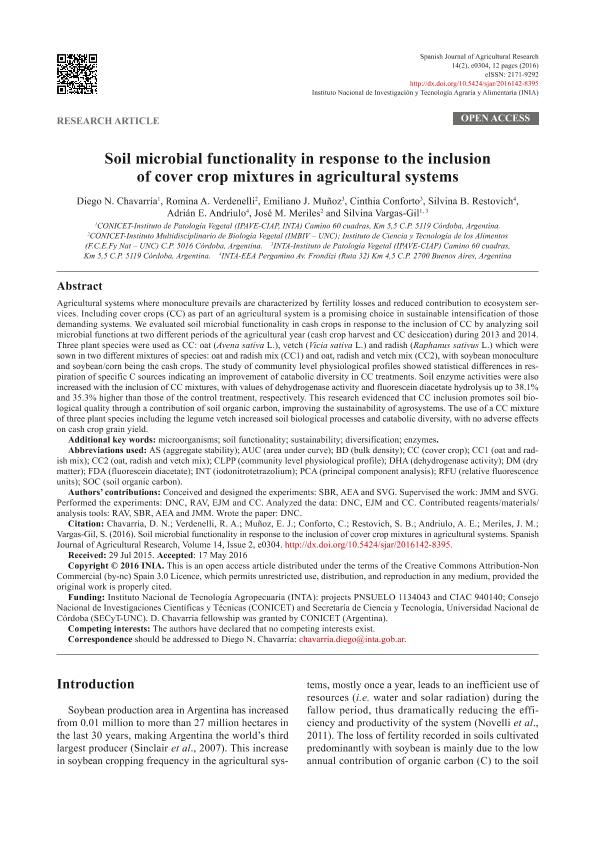Mostrar el registro sencillo del ítem
dc.contributor.author
Chavarría, Diego Nicolás

dc.contributor.author
Verdenelli, Romina Aylen

dc.contributor.author
Munoz, Emiliano
dc.contributor.author
Conforto, Erica Cinthia

dc.contributor.author
Restovich, Silvina Beatriz

dc.contributor.author
Andriulo, Adrian Enrique

dc.contributor.author
Meriles, Jose Manuel

dc.contributor.author
Vargas Gil, Silvina

dc.date.available
2020-07-15T13:25:21Z
dc.date.issued
2016-06
dc.identifier.citation
Chavarría, Diego Nicolás; Verdenelli, Romina Aylen; Munoz, Emiliano; Conforto, Erica Cinthia; Restovich, Silvina Beatriz; et al.; Soil microbial functionality in response to the inclusion of cover crop mixtures in agricultural systems; Spanish National Institute for Agriculture and Food Research and Technology; Spanish Journal Of Agricultural Research; 14; 6-2016; 1-12
dc.identifier.issn
1695-971X
dc.identifier.uri
http://hdl.handle.net/11336/109287
dc.description.abstract
Agricultural systems where monoculture prevails are characterized by fertility losses and reduced contribution to ecosystem services. Including cover crops (CC) as part of an agricultural system is a promising choice in sustainable intensification of those demanding systems. We evaluated soil microbial functionality in cash crops in response to the inclusion of CC by analyzing soil microbial functions at two different periods of the agricultural year (cash crop harvest and CC desiccation) during 2013 and 2014. Three plant species were used as CC: oat (Avena sativa L.), vetch (Vicia sativa L.) and radish (Raphanus sativus L.) which were sown in two different mixtures of species: oat and radish mix (CC1) and oat, radish and vetch mix (CC2), with soybean monoculture and soybean/corn being the cash crops. The study of community level physiological profiles showed statistical differences in respiration of specific C sources indicating an improvement of catabolic diversity in CC treatments. Soil enzyme activities were also increased with the inclusion of CC mixtures, with values of dehydrogenase activity and fluorescein diacetate hydrolysis up to 38.1% and 35.3% higher than those of the control treatment, respectively. This research evidenced that CC inclusion promotes soil biological quality through a contribution of soil organic carbon, improving the sustainability of agrosystems. The use of a CC mixture of three plant species including the legume vetch increased soil biological processes and catabolic diversity, with no adverse effects on cash crop grain yield.
dc.format
application/pdf
dc.language.iso
eng
dc.publisher
Spanish National Institute for Agriculture and Food Research and Technology

dc.rights
info:eu-repo/semantics/openAccess
dc.rights.uri
https://creativecommons.org/licenses/by-nc-sa/2.5/ar/
dc.subject
MICROORGANISMS
dc.subject
SOIL FUNCTIONALITY
dc.subject
SUSTAINABILITY
dc.subject
DIVERSIFICATION
dc.subject
ENZYMES
dc.subject.classification
Otras Ciencias de la Tierra y relacionadas con el Medio Ambiente

dc.subject.classification
Ciencias de la Tierra y relacionadas con el Medio Ambiente

dc.subject.classification
CIENCIAS NATURALES Y EXACTAS

dc.subject.classification
Ciencias del Suelo

dc.subject.classification
Agricultura, Silvicultura y Pesca

dc.subject.classification
CIENCIAS AGRÍCOLAS

dc.title
Soil microbial functionality in response to the inclusion of cover crop mixtures in agricultural systems
dc.type
info:eu-repo/semantics/article
dc.type
info:ar-repo/semantics/artículo
dc.type
info:eu-repo/semantics/publishedVersion
dc.date.updated
2020-07-13T16:09:02Z
dc.identifier.eissn
2171-9292
dc.journal.volume
14
dc.journal.pagination
1-12
dc.journal.pais
España

dc.journal.ciudad
Madrid
dc.description.fil
Fil: Chavarría, Diego Nicolás. Instituto Nacional de Tecnología Agropecuaria. Centro de Investigaciones Agropecuarias. Instituto de Patología Vegetal; Argentina. Consejo Nacional de Investigaciones Científicas y Técnicas. Centro Científico Tecnológico Conicet - Córdoba; Argentina
dc.description.fil
Fil: Verdenelli, Romina Aylen. Consejo Nacional de Investigaciones Científicas y Técnicas. Centro Científico Tecnológico Conicet - Córdoba. Instituto Multidisciplinario de Biología Vegetal. Universidad Nacional de Córdoba. Facultad de Ciencias Exactas Físicas y Naturales. Instituto Multidisciplinario de Biología Vegetal; Argentina
dc.description.fil
Fil: Munoz, Emiliano. Instituto Nacional de Tecnología Agropecuaria. Centro de Investigaciones Agropecuarias. Instituto de Patología Vegetal; Argentina
dc.description.fil
Fil: Conforto, Erica Cinthia. Instituto Nacional de Tecnología Agropecuaria. Centro de Investigaciones Agropecuarias. Instituto de Patología Vegetal; Argentina
dc.description.fil
Fil: Restovich, Silvina Beatriz. Instituto Nacional de Tecnología Agropecuaria; Argentina
dc.description.fil
Fil: Andriulo, Adrian Enrique. Instituto Nacional de Tecnología Agropecuaria; Argentina
dc.description.fil
Fil: Meriles, Jose Manuel. Consejo Nacional de Investigaciones Científicas y Técnicas. Centro Científico Tecnológico Conicet - Córdoba. Instituto Multidisciplinario de Biología Vegetal. Universidad Nacional de Córdoba. Facultad de Ciencias Exactas Físicas y Naturales. Instituto Multidisciplinario de Biología Vegetal; Argentina
dc.description.fil
Fil: Vargas Gil, Silvina. Instituto Nacional de Tecnologia Agropecuaria. Centro de Investigaciones Agropecuarias. Unidad de Fitopatologia y Modelizacion Agricola. - Consejo Nacional de Investigaciones Cientificas y Tecnicas. Centro Cientifico Tecnologico Conicet - Cordoba. Unidad de Fitopatologia y Modelizacion Agricola.; Argentina
dc.journal.title
Spanish Journal Of Agricultural Research

dc.relation.alternativeid
info:eu-repo/semantics/altIdentifier/doi/http://dx.doi.org/10.5424/sjar/2016142-8395
dc.relation.alternativeid
info:eu-repo/semantics/altIdentifier/url/https://revistas.inia.es/index.php/sjar/article/view/8395
Archivos asociados
